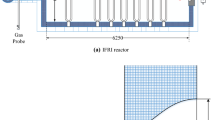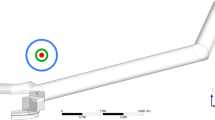In this study, for predicting situations that may occur when using oxy-coal combustion technology in a cement rotary kiln, computational fluid dynamics (CFD) methodology was used to investigate the temperature distribution, burnout rates of coal, flame shape and release of NO x in conditions of oxy-coal combustion with different O2/N2 volume ratios ranging between 21% and 31% in the primary air in the sintering zone of a rotary kiln. Simulations were performed using ANSYS-CFX, a commercial CFD package. The results revealed a significant temperature increase in the rotary kiln, and the average temperature increase value was verified experimentally. Coal particles combust more rapidly near the burner, and the final degree of burnout increases simultaneously. Increased combustion efficiency reduces fuel consumption. However, shifting the ignition point toward the burner may reduce the service time of the burner, and the shortening of the flame kernel may lead to a decrease in the calcination time of cement. The content of oxygen in the kiln rises, but the change is slight and can be ignored for cement clinker formation. The amount of NO x, produced increases with increasing oxygen content in the primary air. The results of this study can be used to select the optimal sintering parameters for oxy-coal combustion in industrial production of cement.






Similar content being viewed by others
References
T. Guo, X. P. Peng, J. K. Liu, et al., Cement Technology, 1, No. 46-48 (2015).
J. Wang, Y. B. Li, H. Y. Liao, et al., NORTH CHINA ELECTRIC POWER, 08, No. 56-61 (2014).
R. Yoshiie, N. Hikosaka, Y. Nunome, et al., Fuel Process. Technol., 136, No. 106-111 (2015).
A. M. Cormos and C. C. Cormos, Reducing the carbon footprint of cement industry by post-combustion CO2 capture: Techno-economic and environmental assessment of a CCS project in Romania, Chemical Engineering Research and Design (2017).
W. Fan, Y. Li, Q. Guo, et al., Energy ,125, No. 417-426 (2017).
L. Alvarez, M. Gharebaghi, J. M. Jones, et al., Applied Energy, 104, No. 653-665 (2013).
E. Mastorakos, A. Massias, C. D. Tsakiroglou, et al., Appl. Math. Modelling, 23, No. 1,55-76 (1999).
ECRA, ECRA CCS Project - Report about phase II, ECRA (European Cement Research Academy), Duesseldorf, Germany (2009).
R. M. Davidson and S. 0. Santos, Int. J. Greenh. Gas Con., No. 5,5-15 (2011).
T. Wall, R. Stanger and S. Santos, "Demonstrations of coal-fired oxy-fuel technology for carbon capture and storage and issues with commercial deployment," Int. J. Greenh. Gas Con., 5,5-15 (2011).
P. Edge, M. Gharebaghi, R. Irons, et al., Chemical Engineering Research and Design, 89, No. 9, 1470-1493 (2011).
K. Masaki and I. Maki, Cement and Concrete Research, 32, No. 6,931-934 (2002).
D. K. Fidaros, C. A. Baxevanou, C. D. Dritselis, et al., Powder Technol., 171, No. 2,81-95 (2007).
N. N. Xing and W. L. Zhao, "Advanced Materials Research," Trans Tech Publications, 255,4232-4236 (2011).
A. C. Jones and D. B. Launder, Lectures in Mathematical Models of Turbulence (1972).
J. E. Macphee, M. Sellier, M. Jermy, et al., Seventh international conference on CFD in the minerals and process industries, CSIRO, Melbourne, Australia. 9(11) (2009).
S. Badzioch and P. G. W Hawksley, Ind. Eng. Chem. Proc. D. D., 9, No. 4,521-530 (1970).
T. F. Wall, W. J. Phelan, and S. Bartz, International Flame Research Foundation Report F, 388 (1986).
D. A. Granados, F. Chejne, J. M. Mejia, et al., Energy, 64,615-62 (2014).
This work was supported by the National Key Research and Development Program of the PRC 2016YFB0601502.
Author information
Authors and Affiliations
Additional information
Translated from Khimiya i Tekhnologiya Topliv i Masel, No. 5, pp. 79 — 84, September — October, 2018.
Rights and permissions
About this article
Cite this article
Ying, Z., Lixin, C., Qiao, L. et al. Simulating the Process of Oxy-Fuel Combustion in the Sintering Zone of a Rotary Kiln to Predict Temperature, Burnout, Flame Parameters and the Yield of Nitrogen Oxides. Chem Technol Fuels Oils 54, 650–660 (2018). https://doi.org/10.1007/s10553-018-0971-2
Published:
Issue Date:
DOI: https://doi.org/10.1007/s10553-018-0971-2




